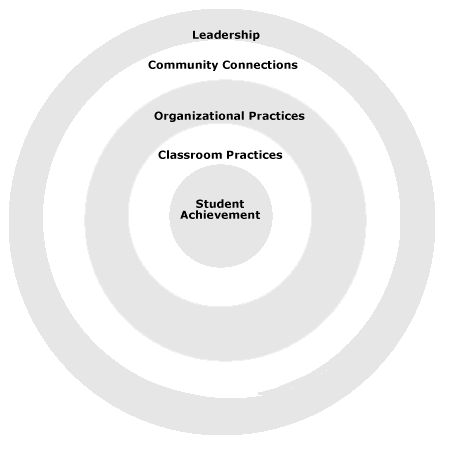 A working group of the CES National Congress, made up of representatives from schools and Centers, has since 1998 collaborated on drafting a set of specific descriptions (or “indicators”) into “benchmarks” that outline what the work of the Coalition “looks like.” A number of Centers and schools are currently pilot testing the benchmarks to help focus school practices on improving student achievement; they will be revised accordingly.
A working group of the CES National Congress, made up of representatives from schools and Centers, has since 1998 collaborated on drafting a set of specific descriptions (or “indicators”) into “benchmarks” that outline what the work of the Coalition “looks like.” A number of Centers and schools are currently pilot testing the benchmarks to help focus school practices on improving student achievement; they will be revised accordingly.
These benchmarks are organized in two sets, either of which can help a school assess its own practices. One set takes each Common Principle in turn and describes how it looks when applied in five interconnected categories: Student Achievement, Classroom Practice, Organizational Practice, Community Connections, and Leadership. (The visual depiction below indicates how each of these coexists in its support of the central goal, student achievement.)
*Please see the graphic image in the upper right corner.
The second set, alternatively, takes each of those five categories in turn and describes how the Ten Common Principles show up in its particular context. The draft that follows in these two pages illustrates this approach, using “Organizational Practice” as an example:
ORGANIZATIONAL PRACTICE BENCHMARK
Putting the Ten Common Principles into practice requires that schools orient their organizational structures and practices – such as schedule, professional development, decision-making, and teacher collaboration – to directly support powerful teaching and learning. CES provides an explicit framework for coherent whole school change and the development of the school as a reflective learning organization focused on supporting improved student achievement. CES schools will show evidence of:
Common Principle 1: The school should focus on helping children learn to use their minds well.
a. Professional development and support system that are framed around intellectual rigor and habits of the mind (see Student Achievement, Principle 1)
b. A learning community of stakeholders, spokespeople and publications that articulate the philosophical foundation of the school (i.e. what “habits of mind” are, how the school addresses emotional and social components, what high levels of learning for all students means)
c. School and community resources that are available and well integrated (that is, libraries, technologies, support programs) to support intellectual purposes
Common Principle 2: The school’s goals should be simple: that each student master a limited number of essential skills and areas of knowledge.
a. An academic program that is designed to support cross disciplinary work and traditional academic departmentalization is limited
b. Forums that encourage discussions of “less is more” and professional development opportunities help teachers design curriculum effectively
c. Programs and field trips (i.e. community service, work study, internships) that connect “inside-school” learning to the community and “real world”
Common Principle 3: The school’s goals should apply to all students.
a. The collection, disaggregation (i.e. by race, ethnicity, gender, disability), and analysis of student data by individual teachers and the school so that patterns related to student achievement (i.e. school placement, test scores, course selection, post graduate plans) can emerge
b. A challenging curriculum and promotion/graduation standards that apply to all students – no tracking
c. School activities and resources (financial and human) that are allocated in ways that give all students access to the most effective teaching and learning.
